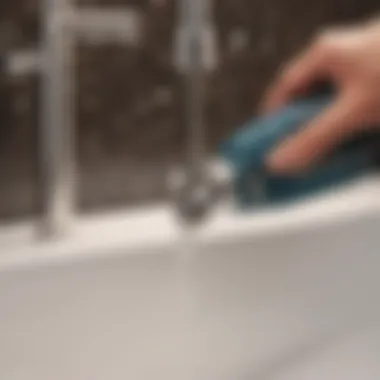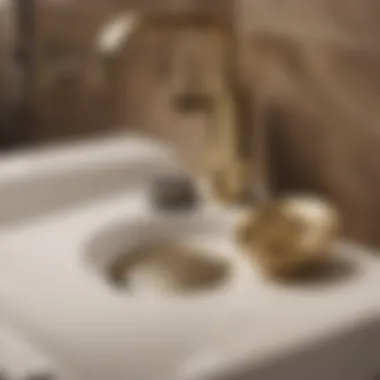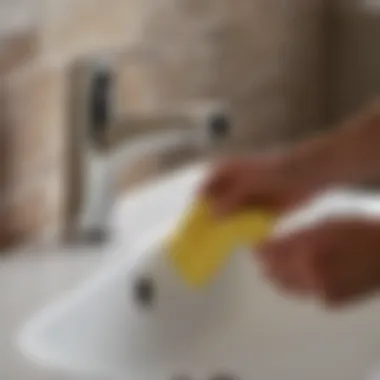Step-by-Step Guide to Replacing Your Bathroom Sink Drain Easily


Materials:
- New bathroom sink drain assembly
- Plumbers putty
- Adjustable wrench
- Slip-joint pliers
- Silicon caulk
- Putty knife
- Bucket
DIY Steps:
- Preparation:
- Removing the Old Drain:
- Preparing for Installation:
- Installing the New Drain:
- Finishing Touches:
- Start by clearing out the area under the sink for easy access.
- Turn off the water supply to the sink.
- Use the adjustable wrench to loosen the slip-nut connecting the P-trap to the old drain.
- Unscrew the locknut connecting the drain to the sink and remove the old drain.
- Clean the area where the old drain was removed using a putty knife.
- Roll a thin bead of plumbers putty and apply it around the flange of the new drain.
- Insert the new drain into the sinkhole and secure it with the locknut provided.
- Attach the P-trap and tighten the slip-nut to prevent any leaks.
- Apply a line of silicon caulk around the edges of the drain flange for added protection.
- Turn on the water supply and check for any leaks.
Technical Aspects:
The tools required for this project include an adjustable wrench, slip-joint pliers, a putty knife, and a bucket for excess water drainage. The timing for this project can vary but typically takes about 30-60 minutes to complete. Critical techniques involve ensuring proper sealing with plumbers putty and silicon caulk to prevent leaks.
DIY Project Process:
The sequential steps involved in replacing a bathroom sink drain are crucial for a successful outcome. Each step must be followed meticulously to avoid any issues during installation. Proper timing and technique are essential to elevate the quality of the project.
Troubleshooting Tips:
If you encounter leaks after installation, check the tightness of the connections and re-tighten if needed. Ensure the plumbers putty and silicon caulk are applied correctly to create a watertight seal. If leaks persist, seek professional assistance to avoid further damage.
Introduction
In the realm of home renovations, tackling a bathroom sink drain replacement is a task that yields both practical functionality and aesthetic appeal. The intrinsic value of a well-functioning sink drain cannot be overstated, as it plays a pivotal role in maintaining a hygienic and efficient bathroom environment. This article serves as a comprehensive roadmap for housewives and homeowners venturing into the realm of plumbing DIY projects.
Understanding the nuances of a functional sink drain goes beyond mere plumbing mechanics; it delves into the heart of a seamless daily routine. Imagine the frustration of dealing with slow drainage or persistent leaks – inconveniences that disrupt the tranquil oasis of a bathroom retreat. By comprehensively addressing the intricacies of sink drain replacement, this guide empowers individuals to take charge of their home maintenance, fostering a sense of accomplishment and self-sufficiency.
Embarking on the journey of replacing a bathroom sink drain entails considerations far beyond the physical act of installation. From selecting the appropriate tools to mastering the installation steps, each element contributes to the overarching success of the project. Embracing this endeavor not only enhances one's practical skills but also instills a sense of pride in transforming a mundane household fixture into a seamless, efficient component of daily life.
The significance of this introductory segment lies in setting the stage for a meticulous exploration of sink drain replacement. By laying a strong foundation of understanding and motivation, readers are poised to embark on a journey that promises not just a functional outcome but a transformative experience in home maintenance and enhancement.
Understanding the Importance of a Functional Sink Drain


When it comes to your bathroom, every component plays a crucial role in ensuring functionality and efficiency. Amongst these components, the sink drain holds a pivotal position in maintaining a hygienic and organized space. Understanding the importance of a functional sink drain is imperative in the context of this article as it sets the foundation for a successful replacement process.
A functional sink drain not only facilitates the smooth flow of water but also prevents clogs and potential leakages that can lead to costly repairs. By grasping the significance of a well-maintained sink drain, homeowners can ensure a seamless water drainage system that enhances daily routines and overall cleanliness.
Furthermore, a functional sink drain contributes to the longevity of your bathroom fixtures by minimizing water damage and mold growth. By addressing any issues or inefficiencies in the sink drain proactively, homeowners can avoid more significant problems down the line, saving both time and money in the long run.
In this article, the emphasis on understanding the importance of a functional sink drain serves as a reminder to prioritize the maintenance and care of this essential bathroom feature. By shedding light on the benefits and considerations related to a functional sink drain, readers will gain a deeper appreciation for this seemingly ordinary yet vital component of their daily lives.
Tools and Materials Needed
When embarking on the task of replacing a bathroom sink drain, ensuring you have the appropriate tools and materials is crucial to a successful outcome. A well-equipped toolbox will not only make the process smoother but also guarantee a job well done, avoiding any pitfalls along the way. Let's delve into the essential tools and required materials that will aid you in accomplishing this project seamlessly.
Essential Tools
Adjustable Wrench
The adjustable wrench is a versatile tool that plays a pivotal role in loosening and tightening various plumbing components, including nuts and bolts. Its adjustable design allows it to fit different sizes of nuts, making it a convenient choice for this project. The ergonomic handle provides a comfortable grip, enhancing control and maneuverability. With its sturdy construction, the adjustable wrench is a durable tool that withstands the torque needed for plumbing tasks. However, due to its adjustable nature, care must be taken to ensure a proper fit to prevent slipping and potential damage to the nuts.
Plumbers Putty
Plumbers putty is a sealing agent essential for creating a watertight seal between sink surfaces and drain components. It is pliable and easy to work with, providing a reliable barrier against leaks. The key characteristic of plumbers putty lies in its flexibility and resistance to shrinking or hardening over time, ensuring long-lasting results. While plumbers putty is a popular choice for sealing sink drains, it is important to note that it should not be used with certain types of sinks, such as natural stone, as it may cause discoloration.
Pipe Wrench
The pipe wrench is a specialized tool designed for gripping and turning pipes and fittings securely. Its adjustable jaw allows it to adapt to various pipe diameters, granting versatility in tackling different plumbing tasks. The hardened steel construction of the pipe wrench delivers exceptional strength and durability, capable of withstanding high levels of torque. With its distinctive self-tightening feature, the pipe wrench provides a secure grip on pipes, minimizing slippage during use. However, its bulkier size may pose challenges in confined spaces, requiring careful maneuvering to access tight areas.
Bucket
A humble yet indispensable tool, the bucket serves multiple purposes during the sink drain replacement process. It acts as a container for catching water and debris from the old drain, preventing spillage and mess around the area. The bucket also provides a convenient vessel for organizing and transporting tools and parts, keeping everything within reach and organized for efficient work. Its sturdy construction ensures durability, capable of withstanding the demands of plumbing tasks.
Required Materials
New Sink Drain Kit
The new sink drain kit comprises essential components required for installing a new drain system, such as the drain pipe, strainer, and any accompanying hardware. It offers a comprehensive solution for upgrading your sink's drainage functionality, ensuring a proper fit and reliable performance. The key characteristic of a new sink drain kit is its compatibility with standard sink sizes, providing a universal solution for most installations. While convenient and cost-effective, some variations in design may require additional adjustments during installation.
Teflon Tape
Teflon tape, also known as plumber's tape, is a thread sealant used to create a tight, leak-free seal between threaded pipe joints. Its high-density material provides a secure barrier against leaks, promoting efficient water flow within the plumbing system. The key characteristic of Teflon tape lies in its flexibility and resistance to chemicals and extreme temperatures, ensuring long-term sealing reliability. While widely favored for its ease of application and effectiveness, proper wrapping technique is essential to prevent tape unraveling and ensure a snug fit.
Clean Cloth
A clean cloth serves as a versatile tool for various tasks throughout the sink drain replacement process. It plays a crucial role in wiping down surfaces, removing debris, and maintaining a clean work area free of contaminants that could interfere with the installation. The key characteristic of a clean cloth lies in its absorbency and lint-free composition, preventing streaks or residue on surfaces. While seemingly basic, a clean cloth is indispensable for achieving a professional finish, ensuring every detail is attended to with precision.


Preparing for the Replacement
The Importance of Preparing for the Replacement
Preparing for the replacement of a bathroom sink drain is a crucial step in ensuring a smooth and successful process. By properly preparing, you set the foundation for a hassle-free installation, reduce the chances of potential issues, and ultimately save time and effort. This stage allows you to gather the necessary tools and materials, assess the work area, and mentally plan out each step of the replacement.
Benefits of Adequate Preparation
Adequate preparation before replacing a bathroom sink drain offers a myriad of benefits. It allows you to avoid unexpected interruptions during the installation, minimizes the risk of damaging surrounding fixtures or surfaces, and helps streamline the overall process. Moreover, by taking the time to prepare meticulously, you enhance the precision and accuracy of the replacement, leading to a professional-looking result.
Key Considerations for Preparing for the Replacement
When preparing for the replacement of a bathroom sink drain, consider factors such as ensuring you have all the necessary tools and materials at hand. Additionally, double-check that the water supply can be easily shut off to prevent any leaks or water damage. Clear the area around the sink to provide ample space for maneuvering and working comfortably. By meticulously addressing these considerations, you pave the way for a successful and efficient replacement process.
Shutting Off Water Supply
Shutting off the water supply is a critical step in preparing for the replacement of a bathroom sink drain. It ensures that no water flows while you dismantle the old drain and install the new one, preventing potential leaks or water damage. Start by locating the shut-off valves usually located under the sink. Turn the valves clockwise until fully closed to stop the water supply.
Clearing the Area
Clearing the area around the sink is essential to create a conducive work environment for replacing the bathroom sink drain. Remove any items or clutter from under the sink and adjacent countertops to have sufficient space to maneuver and access the plumbing easily. Taking the time to clear the area minimizes obstacles and enhances efficiency during the installation process.
Removing the Old Sink Drain
When undertaking the task of replacing a bathroom sink drain, a crucial step is removing the old sink drain. This part of the process sets the foundation for a successful installation of the new components.
Dismantling the existing drain ensures that any corrosion, clogs, or damage present in the old components are effectively eliminated. By taking apart the old drain pipes and fittings, you can thoroughly inspect each part for wear and tear, ensuring that the new drain is installed on a clean and properly functioning surface. This step helps prevent any potential issues such as leaks or blockages in the future.
Additionally, dismantling the existing drain allows you to assess the condition of the surrounding plumbing. Any signs of deterioration or damage can be addressed before installing the new components, thereby preventing future maintenance headaches. It also provides an opportunity to determine if any upgrades or adjustments are needed to enhance the overall performance of the sink drainage system.
Dismantling the Existing Drain
To begin dismantling the existing drain, start by using an appropriate tool such as a pipe wrench or adjustable wrench to loosen and remove the connections between the various components. Carefully unscrew any nuts or fittings holding the drain pipes in place, being mindful not to force or damage them in the process.
Once you have disconnected the pipes, carefully remove them from the sink and examine each part for any signs of damage or corrosion. Inspect the drain strainer and flange for buildup of debris or grime, which can impede water flow and lead to blockages. Clean these components thoroughly to ensure optimal performance of the new drain system.
Cleaning the Drain Opening
After removing the old drain components, turn your attention to cleaning the drain opening. Use a clean cloth to wipe away any excess residue or grime around the opening to ensure a proper seal when installing the new drain. Inspect the opening for any remnants of the old plumber's putty or sealant, as these can hinder the effectiveness of the new installation.
Using a mild cleaning solution, sanitize the area around the drain opening to eliminate any bacteria or odor-causing particles. A clean surface promotes better adhesion and sealing of the new drain components, reducing the likelihood of leaks or contamination. Ensure that the area is completely dry before proceeding with the installation process for a seamless transition to the next step.
Installing the New Sink Drain


In the process of replacing a bathroom sink drain, installing the new sink drain is a pivotal step that ensures the functionality and longevity of your sink system. This section delves into the essential aspects of installing the new sink drain, highlighting the significance and key considerations to guarantee a successful outcome.
Applying Plumbers Putty
When installing the new sink drain, one crucial aspect is applying plumber's putty. Plumbers putty is a soft, pliable sealing compound used to create a watertight seal around the drain opening. To apply plumber's putty effectively, start by rolling a thin rope of putty and wrapping it around the underside of the drain flange. Ensure the putty forms a complete seal to prevent any water leakage. Excess putty can be easily trimmed off once the drain is in place. Applying plumber's putty correctly is vital to prevent water seepage and maintain the integrity of your sink system.
Attaching the New Drain Components
Another essential step in installing the new sink drain is attaching the new drain components. This process involves connecting the tailpiece, P-trap, and any additional fittings to complete the drainage system. Prioritize aligning the components correctly and securing them tightly to prevent leaks. Use a pipe wrench to tighten the connections firmly but ensure not to over-tighten, which could damage the fittings. Checking for any potential obstructions or misalignments before finalizing the connection is crucial to guarantee proper drainage flow. By attaching the new drain components meticulously, you ensure a functional and leak-free sink system, enhancing the overall efficiency and performance of your bathroom sink.
Testing and Checking for Leaks
Once the new sink drain has been installed, the crucial step of testing and checking for leaks comes into play. This step ensures that the entire replacement process has been executed correctly, and the sink will function flawlessly without any unwanted leaks.
When testing for leaks, start by slowly turning on the water supply. Watch closely for any signs of water seepage or dripping around the newly installed drain components. It is essential to be meticulous in this observational phase to detect even the tiniest of leaks.
One of the primary benefits of conducting a thorough leak check is to prevent water damage to the surrounding areas of the sink. Leaks can lead to mold growth, rotting of cabinets, or even structural damage if left unnoticed. By diligently testing for leaks, you safeguard your bathroom from potential costly repairs in the future.
Another critical aspect to consider during the leak testing process is the tightness of the connections. Check all the connections of the new sink drain components, including the P-trap, tailpiece, and the slip nuts, to ensure they are securely fastened. Loosely connected fittings can result in leaks over time, compromising the integrity of the entire drainage system.
Moreover, observing for leaks provides peace of mind that the replacement has been accurately carried out. It acts as a final quality assurance measure before proceeding to regular use of the sink. By detecting and addressing any leaks promptly, you guarantee a functioning and efficient sink system.
Final Checks and Cleanup
After successfully installing the new bathroom sink drain, the final stage involves conducting thorough checks and ensuring proper cleanup to guarantee a well-functioning and aesthetically pleasing outcome. This part of the process is crucial as it helps in detecting any possible issues or leaks that may have arisen during installation.
Turning On Water Supply
Once you have securely attached the new sink drain components and applied the plumber's putty, the next step involves turning on the water supply. This is a crucial moment as it allows you to check for any leaks or potential issues that may require immediate attention. Slowly turn on the water supply and observe the newly installed sink drain for any signs of dripping water or leaks. If you notice any leaks, promptly address them by tightening the connections or reapplying the plumber's tape.
Wiping Down the Area
As the final step of the installation process, thoroughly wipe down the area surrounding the newly installed sink drain. Use a clean cloth to remove any excess plumber's putty or dirt that may have accumulated during the replacement process. Ensuring the area is clean not only enhances the visual appeal of the bathroom but also prevents any potential clogs or blockages caused by debris. Additionally, a clean and dry surface around the sink drain contributes to maintaining a hygienic environment in the bathroom.
Conclusion
Conclusion
In this comprehensive guide on replacing a bathroom sink drain, the conclusion serves as a vital aspect that ties together the entire process. As we reach the end of this detailed journey, it's crucial to highlight the significance of the conclusion in ensuring the successful completion of the task. The conclusion not only marks the final step of the project but also signifies the beginning of enjoying the fruits of your labor.
One of the key elements to focus on in the conclusion is the satisfaction of knowing that you have successfully replaced your bathroom sink drain. This feeling of accomplishment can bring a sense of pride and empowerment, especially for housewives and house owners who take pride in maintaining their homes.
Moreover, the conclusion allows you to inspect your work thoroughly one last time, ensuring that everything is in place and functioning correctly. It provides an opportunity to double-check for any leaks or issues that may have arisen during the installation process.
Additionally, the conclusion serves as a moment of reflection where you can appreciate the effort and precision that went into replacing the sink drain. It gives you a chance to step back and admire your handiwork, appreciating the improved functionality and aesthetics it brings to your bathroom.
Furthermore, considerations about the conclusion should also include cleaning up the work area and restoring it to its original state. Wiping down any surfaces, organizing tools, and disposing of any waste materials are essential tasks to ensure the project's completion in a neat and tidy manner.
In essence, the conclusion of replacing a bathroom sink drain not only marks the end of a meticulous installation process but also symbolizes the beginning of a functional and aesthetically pleasing bathroom. It encapsulates the efforts, attention to detail, and satisfaction that come with successfully completing a home improvement project.







